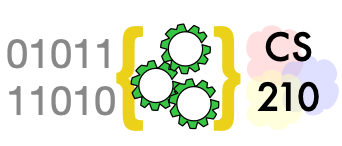Other Nested Structures#
Nested lists are by far the most common recursive data structure (aside from tree structures built from programmer-defined classes, which we will introduce in Part II of this text). However, other collection data types in Python including lists, dictionaries, and tuples, can also be nested.
Data exchange languages#
We often need to transmit data between applications that may not be coded in the same programming language. For example, the “server side” of a web application, which runs within a web server or acts as a web server itself, must transmit and receive data from the “client side” of the application, which is typically a JavaScript program running within a browser. While any particular message (say, a weather report) may have a fixed and predictable content, the transmission is almost always in a data exchange format which is defined by a recursive data structure.
Among the most common data exchange formats in use today is
JavaScript Object Notation (JSON). The first
example offered at json.org
looks (and is semantically) identical to a nested structure of
dicts in Python:
{
"glossary": {
"title": "example glossary",
"GlossDiv": {
"title": "S",
"GlossList": {
"GlossEntry": {
"ID": "SGML",
"SortAs": "SGML",
"GlossTerm": "Standard Generalized Markup Language",
"Acronym": "SGML",
"Abbrev": "ISO 8879:1986",
"GlossDef": {
"para": "A meta-markup language, used to create markup languages such as DocBook.",
"GlossSeeAlso": ["GML", "XML"]
},
"GlossSee": "markup"
}
}
}
}
}
The Mozilla Developer Network (MDN) introduction to JSON, which uses JavaScript terminology (e.g., a “objects” rather than “dicts”) offers an example that (in Python terms) nests lists within dictionaries, and dictionaries within lists:
{
"squadName": "Super hero squad",
"homeTown": "Metro City",
"formed": 2016,
"secretBase": "Super tower",
"active": true,
"members": [
{
"name": "Molecule Man",
"age": 29,
"secretIdentity": "Dan Jukes",
"powers": ["Radiation resistance", "Turning tiny", "Radiation blast"]
},
{
"name": "Madame Uppercut",
"age": 39,
"secretIdentity": "Jane Wilson",
"powers": [
"Million tonne punch",
"Damage resistance",
"Superhuman reflexes"
]
},
{
"name": "Eternal Flame",
"age": 1000000,
"secretIdentity": "Unknown",
"powers": [
"Immortality",
"Heat Immunity",
"Inferno",
"Teleportation",
"Interdimensional travel"
]
}
]
}
The Python json module
can automatically convert JSON text to a nested structure of
dictionaries and lists, and vice versa. JSON libraries exist for
many other programming languages as well.
Our treemap project, introduced at the end of this chapter, reads JSON inputs and uses nested dictionaries and lists to represent groupings of student majors according to the divisions of a university.
Recursive Dictionary Example#
Suppose we represented a business organization using nested dictionaries, like this:
Yoyodyne = {
"Manager": "John Whorfin",
"Enemy": "Banzai Institute",
"Divisions": {
"Dimensional Engineering": {
"Manager": "John O'Connor",
"Staff": ["John Gomez", "John Yaya"]
},
"Operations": {
"Manager": "John Bigboote",
"Staff": ["John Small Berries", "John Many Jars"]
}
}
}
Suppose that we wished to build a function that, given the name of a staff member, returned that member’s chain of managers. We could look in each level of organization searching for the staff member’s name:
OrgChart = str | list[str] | dict[str, 'OrgChart']
def is_employed_at(person: str, org: OrgChart) -> bool:
"""Returns True iff person is found somewhere in org.
>>> is_employed_at("John Many Jars", Yoyodyne)
True
>>> is_employed_at("John O'Connor", Yoyodyne)
True
>>> is_employed_at("Buckaroo Banzai", Yoyodyne)
False
>>> is_employed_at("Dr. Emilio Lizardo", Yoyodyne)
False
"""
if isinstance(org, str):
return person == org
if isinstance(org, list):
return person in org
if isinstance(org, dict):
for role, division in org.items():
if is_employed_at(person, division):
return True
return False
# Defensive programming --- indicate malformed data structure
assert False, f"Not a valid OrgChart: {org}"

